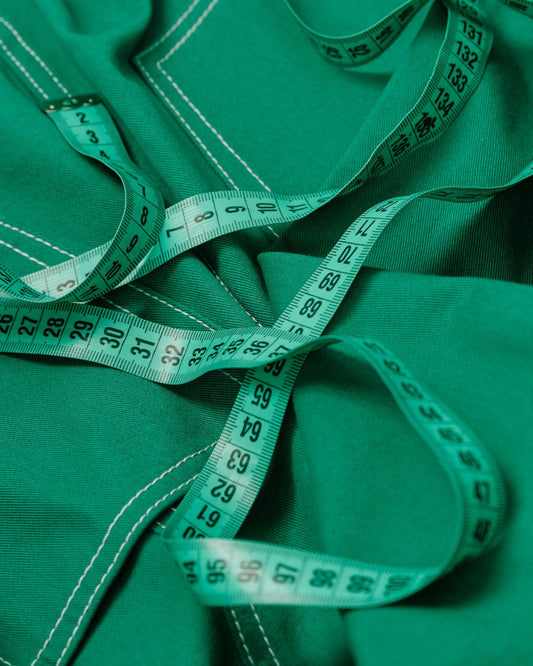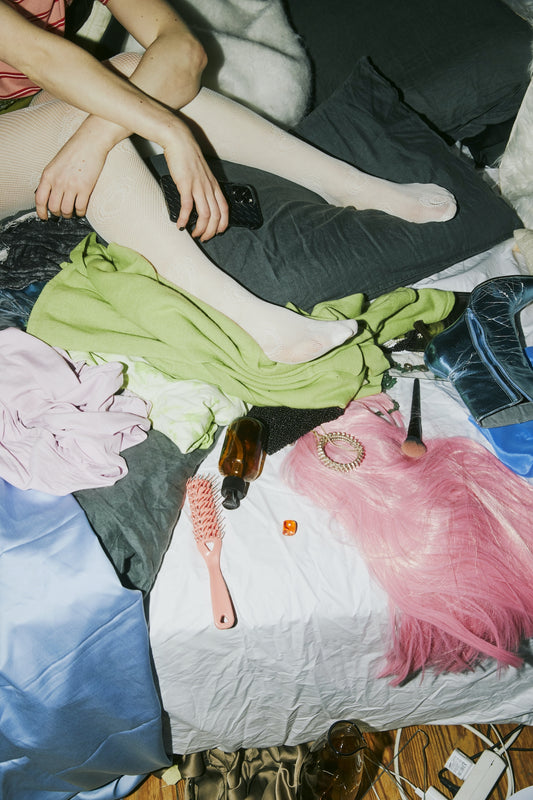The arrival of fast fashion — the rapid cycle of taking designer runway looks straight onto mass produced, cheap and affordable clothing on the high street, is what accelerated fashion waste drastically in the last few decades. This vicious cycle encourages overconsumption, an increasing portion of inventory unsold, an increasing portion of a wardrobe left unworn, and inevitably, all the those clothes go in landfill.
Compared to the days when we used to make our own clothes; visit a seamstress or save for that ‘special piece’ we love and cherish, our access to online shopping, combined with hyper-fad pace of social media, has driven our desire to consume to an overdrive.
From the very beginning, one of Banana’s goals was to be the antidote to this way of doing things. We want to demonstrate that we can all still enjoy fashion without the abundance of clothes in landfills.
“One of the key ways we plan to be a positive force in supporting environmentally responsible design is our preorder model – producing only what is sold,” says Gloria Yu, Banana co-founder.
“Overproduction and excess inventory is a massive sustainability and business problem in fashion. Focusing on a preorder model is not only good for the environment but also reduces the need for creators to forecast sales, invest in inventory and discount products — which only hurts their brands.”
As the fashion industry juggernaut shows no sign of stopping, Banana has been launched to provide the tools, the connections and the support to show creators and consumers how to get back to basics.
The knock-on effect of fast fashion
Getting back to the more traditional approach to designing and making clothes isn’t going to be easy — over the last two decades, fast fashion has radically transformed our relationship with shopping.
It’s not our fault though!
The fashion year used to be divided into seasons — autumn/winter and spring/summer — with perhaps a ‘cruise collection’ somewhere in the middle. These days there’s said to be 52 micro-seasons with new products hitting the shops every week.
Today, the average person buys 60% more clothing than they did in 2000, keeps their clothes for half the time and discards more as a result — less than 1% of used clothing is recycled or reused. To put it into perspective, 92 million tonnes of clothes go into landfill each year.
This constant drive for the new encourages consumption, meaning more stock is ordered by brands and produced by manufacturers to make sure the racks stay full.
Inevitably, this increase in production leads to unsold stock, known in the industry as excess inventory, and the fashion industry is trying to solve the problem of what to do about it.
Luxury brands and overproduction
Between 2000 and 2014, the world’s production of clothes more than doubled, leading the World Economic Forum (WEF) in its 2021 report to identify fast fashion, and its supply chain, as the planet’s third-largest polluter after food and construction.
Yet, while fast fashion attracts most of the ire (and media attention) it's not the only part of the industry facing backlash around overproduction.
In 2021, Vogue Business wrote about American luxury brand Coach going viral after a TikTok video showed it allegedly destroying unsold inventory.
Coach’s global head of digital and sustainability, Joon Silverstein, said at the time that while the video was inaccurate and misleading, Coach was working to avoid the practice of product destruction.
“Finished goods destruction is a very common industry practice,” she said. “Though of course that does not make it right. I can't speak for other brands, but one of Coach’s goals has been zero destruction and that is what we're striving for.”
In the article, Vogue spoke with Anna Sacks, the waste reduction and diversion expert whose video brought the issue to TikTok. “It’s way bigger than Coach,” she said. “They’re the [then current] company that is receiving the negative publicity, but it’s so widespread.”
Silverstein’s right. In 2018, Burberry faced similar criticism when it was reported to be burning unsold inventory — it quickly responded that it would no longer destroy unsellable products.
Overproduction is bad for the planet - and for business.
The ‘why’ behind products being destroyed rather than discounted, recycled or donated is multi-faceted.
In some cases, it’s about brand reputation — a lot of luxury brands would prefer to destroy the stock than discount their prices or donate to second-hand stores — but for others their products simply haven’t been made with disassembly in mind, meaning they can’t be repurposed or recycled.
The solution seems to be for businesses to address the root cause of overproduction, and if they’re not persuaded by the damage being done to the planet, then perhaps they should look at the effect of excess inventory on a business’s bottom line.
In 2022, after year-on-year sales dropped by around $300 million (AUD), the e-commerce heavy hitter ASOS suffered from a major excess inventory situation which led to them having to write off almost $200 million (AUD) of excess stock.
Global apparel brand Gap had a similar experience when it ended its partnership with Kanye West in 2022. Left with piles of unwanted Yeezy stock, as well as an inventory increase of 37% year-on-year, Gap attempted to get rid of stock with heavy promotional periods.
Gap did eventually slim down their inventory, but at a huge cost — its merchandise margin fell by five per cent.
What needs to change?
While it’s easy to put the onus of the problem solely on brands, the manufacturers play a role in all this too.
The facts are that factories will often quote different prices for different production quantities, e.g., $100/pc for orders between 50-199 pieces, and $50/pc for orders between 200-500 pieces.
This means that even if a brand initially just wants to order 100 pieces, it might as well buy 200 pieces because the cost is the same.
Factories set up their prices this way because there’s a ‘setup cost” involved in creating each product in bulk – printing the patterns, cutting the fabrics a certain way, and teaching workers how to sew a particular product.
When factories provide quotes, that setup cost is often embedded and spread out within the cost per product, hence the lower unit cost per product for higher quantity orders.
And finally, there are fabric minimums.
When brands and designers come up with new products they can often need uniquely designed fabrics.
When custom fabrics are needed to bring these products to life – and a unique colour for a certain yarn or fabric counts as custom – there’s a minimum order needed by the producer which is often 1000+ metres. When all the fabric isn’t used, there’s of course going to be a lot of wastage. This is still catgorised as fashion waste going into landfill.
So, what can be done about it?
Through preorder models like Bananas, limited runs on garments, rental programs, reselling software and curated collections, a large number of brands, designers and individual creators are actively chasing change.
Limited runs
Paynter is a UK-based brand that takes iconic jacket styles and remakes them using only the best materials. All jackets are made to order, in limited batches, and orders open just four times a year. The company says that this is the way they’re choosing to eliminate waste in the industry.
Rental programs
Arnsdorf is an Australian sustainable womenswear brand that chose to open its archives up for rent as a way to tackle overconsumption and waste. Others include GlamCorner, Rent the Runway, and Nuuly, among many more.
Preorder models
Banana’s preorder model is how we’re personally choosing to tackle the issue of excess inventory. When creators partner with Banana to bring their designs to life, nothing is made until there is proven demand. This leads to no waste fabric for the producers, no piles of unsold inventory for the creator and unique designs for the consumer.


